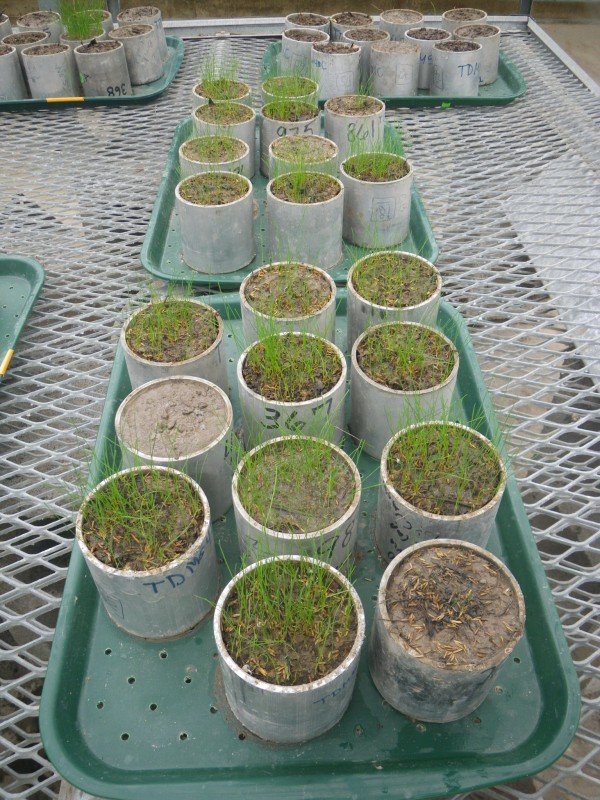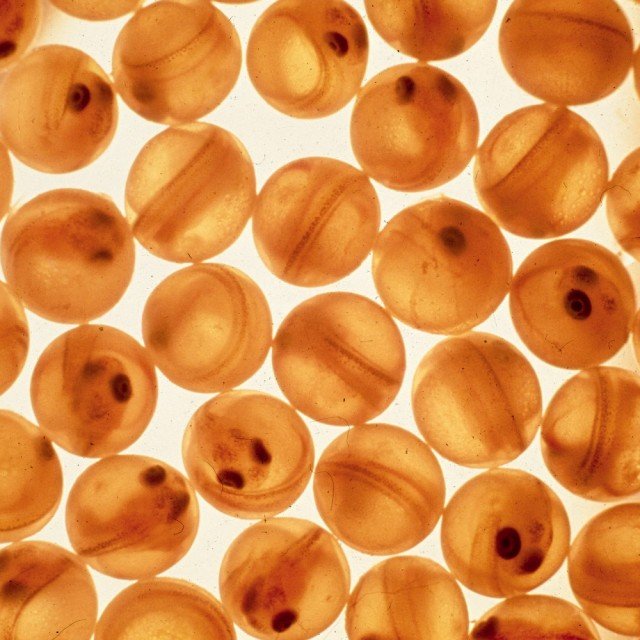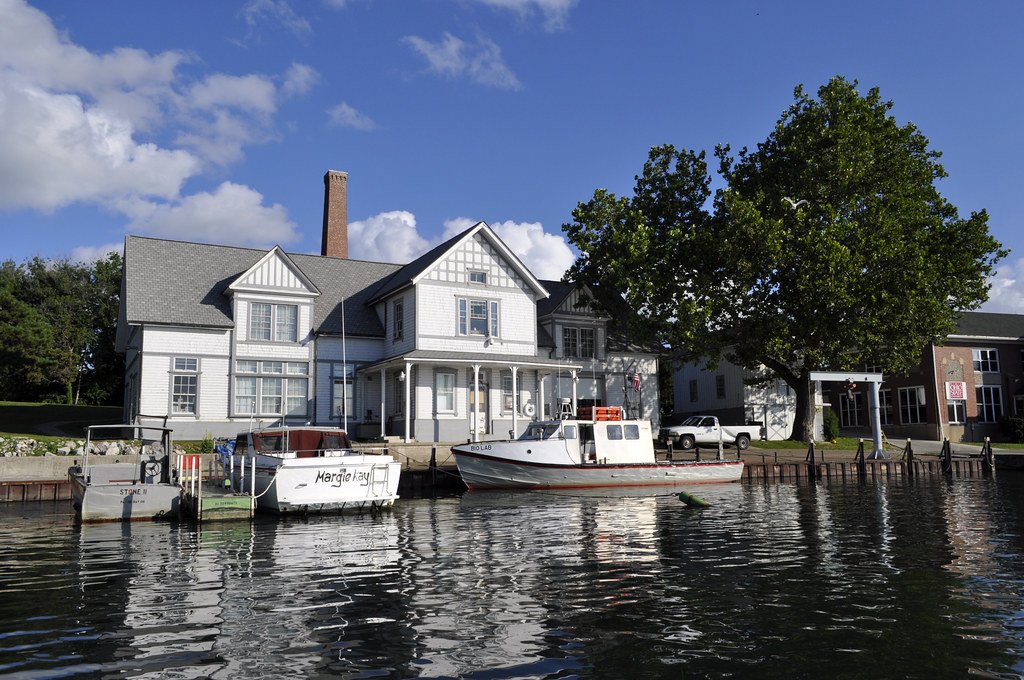New Ohio Sea Grant Project Helps Determine Lake Erie’s Value to Its Residents
For some things, it’s easy to define their value: a pair of jeans or a pizza is worth whatever someone has paid for them. But for others, like a pristine beach or a great fishing spot, worth is much harder to define. In one of the research projects recently funded by Ohio Sea Grant, scientists and economists from Ohio State University will develop an economic model that does just that, to help policy makers decide which conservation practices will raise the value of the Lake Erie ecosystem to its residents and visitors.

Surveying the Landscape
Northwestern Ohio’s landscape is marked mostly by agriculture, with farms of all sizes stretching across the Maumee River watershed and beyond.
A collaborative project, led by Ohio State University, is examining the connection between people’s perception of the health of Lake Erie and the Maumee River watershed, the actual state of these ecosystems, and how both are likely to shift under future influences like climate change. The overall project is funded by a National Science Foundation program aimed at examining the connection between human and natural systems – how humans influence an ecosystem, and how changes in that ecosystem in turn affect humans’ perception of and future actions towards it.

New Life for Dredged Material
Dredging shipping channels is an unavoidable part of harbor maintenance in the western Lake Erie basin. In Toledo, the Army Corps of Engineers removes about one million cubic yards of sediment from the Maumee River each year, washed downstream by heavy rainstorms and agricultural runoff. But once the sediment is removed from the shipping channel, where does it go?
Conservation Assessment Tools
When algal blooms hit Lake Erie, discussions about the blooms’ causes become hot topics in the surrounding communities. But while Lake Erie algal blooms are an important concern for the region, people often don’t think about the impact that those nutrients and sediments can have on the watershed before they reach places like Sandusky Bay. Where do these problematic materials come from? Where do they enter the waterways? How do they affect plant and animal life, both in the stream and along streambanks? And what are the best ways to reduce the impacts of nutrients and sediments, both on local streams and on their eventual destination, Lake Erie?
Digging Deeper Into Science
Between science fair projects and a summer class at Stone Lab, Erin Rogers is already well on her way to a career in the sciences. This summer, the Tippecanoe High School junior from Tipp City, Ohio spent a week at Stone Lab, studying local plants and exploring the Lake Erie shoreline.
Methane Sources in Lake Erie
On a late summer day on Lake Erie, what looks like an upside down bucket, surrounded by an inner tube and attached to hoses and wires, floats next to a Stone Lab research vessel. On the boat, a research team is taking air samples from below the bucket for later analysis, and measuring environmental conditions like air and water temperature.
Dr. Amy Townsend-Small and her students are measuring methane emissions from the surface of Lake Erie. Like carbon dioxide, methane acts as a greenhouse gas in the atmosphere, trapping heat and contributing to global warming.
Fishing for Change
Lake Erie supports some of the most important fisheries in the Great Lakes, and many businesses along the shore rely on this influx of income, from restaurants and hotels to charter fishing operations. But as climate changes in the region, currently popular fish species like yellow perch may become less abundant, potentially forcing industries and customers alike to adapt their habits.
Dr. Stuart Ludsin, Assistant Professor in Ohio State University’s Department of Evolution, Ecology and Organismal Biology (OSU-EEOB), is studying the potential impacts of climate change on fish in the Great Lakes, and focusing particularly on two predicted impacts: warming temperatures and an increase in extreme precipitation.
Sharing Knowledge with a New Generation
Educator classes at Stone Lab don’t just give teachers new ideas for the classroom. For some, that first Stone Lab experience encourages them to expand their lessons beyond the traditional school setting, and may take them farther away from it than they ever expected.
Scott Hoff, a high school teacher at Bluffton Schools in northwestern Ohio, was introduced to Stone Lab 22 years ago, as a first-year teacher.

Bigger, Faster, Stronger
Yellow perch is a staple of Lake Erie restaurant menus, with menu boards along the shore advertising everything from classic fish fry to local specialties. While most of these fish were likely caught in the wild, some of them will have come from aquaculture: fish farms throughout the Great Lakes region raise yellow perch, and aquaculture sales in Ohio tripled from $1.8 million to $6.6 million in 2010.
As with all agriculture products, selective breeding – a process in which parents are selectively bred to enhance specific desired traits in their offspring – has improved production and led to most of the fruits, vegetables, and farm animals we know today. Corn kernels are larger and more uniformly colored than those produced by ancient corn plants, dairy cows produce more milk than their ancestors, and commercial bananas are larger and sweeter than their ancestors, to name just a few examples of genetically improved species.
Tracking Viral Infection in Lake Erie Fish
In the summer of 2006, students at the University of Toledo’s Lake Erie Center made a ghastly discovery on the beach across the street: dead fish washed up on the shore, and struggling fish in the shallow water, all showing bright red hemorrhages on their sides. The students and their instructor, Dr. Carol Stepien, later found out that they had witnessed the first outbreak of viral hemorrhagic septicemia virus, or VHSv, in western Lake Erie.
Improving Business
Ohio Sea Grant’s annual Charter Captains Conference has become a tradition for Lake Erie charter boat captains, with many attendees regularly returning for the latest updates in Lake Erie fishing, regulations, and business opportunities. This year’s conference was no exception, with more than half of the 168 attendees indicating that they had been to a previous conference.

Future Research Leaders Made Here
South Bass Island is mostly known as a summer vacation spot on the Lake Erie islands, full of restaurants, marinas, and hotels. However, the island also hosts Ohio State University’s Stone Laboratory, the oldest freshwater field station in the United States and the center of Ohio Sea Grant’s teaching, research, and outreach work on Lake Erie.
A Summer of Learning
Stone Lab classes give students the opportunity to experience field science first-hand, to catch up on college credits or get a head start on major requirements, and to simply have a great time learning with other students. Of course, for some students, a Stone Lab summer can be all of those things and more.
Teacher at Sea
Professional development for teachers can come in many forms, from online lectures to week-long field experiences and everything in between. One of the most competitive options out there is the Teacher at Sea Program, run by the National Oceanographic and Atmospheric Administration (NOAA). More than 200 teachers apply to the program each year, but less than 30 are usually selected to join NOAA researchers in the field.
This year, Stone Lab Education and Outreach Associate Angela Greene was one of those teachers. Greene, who teaches science at Tecumseh Middle School in New Carlisle, Ohio, sailed on the NOAA ship Gordon Gunter, and participated in a survey of northern right whale populations in the North Atlantic.

Ohio Study Shows the Value of Lake Erie Shoreline Recreational Fishing
Lake Erie shoreline anglers — those who fish from shore locations like docks and jetties instead of boats – value their fishing at an annual average of $13.5 million, a study from Ohio State University Extension, Ohio Sea Grant, and the Ohio Department of Natural Resources (ODNR) Division of Wildlife has found. Shoreline anglers also spend an additional $1.1 million in communities near their fishing destinations on things like food, gas, and last-minute supplies.
Lessons from History
We’ve all seen them: communities along the Lake Erie shoreline that once played host to thriving industrial and manufacturing businesses, but have fallen on hard times as those industries move away. Many Lake Erie cities are now trying to take advantage of their location on the shoreline to attract visitors, focusing on tourism as the major industry in town. But some economists worry that switching from one exclusive industry focus – manufacturing – to another – tourism – could lead to the same problems as before if tourism becomes negatively affected.

Predicting the Bloom
Bright green waters, often capped with foam. Floating mats of algae washing up on the shoreline. And an invisible toxin that can cause rashes, breathing and nervous system problems, and liver damage.
Harmful algal blooms (HABs) can have many negative impacts on the Lake Erie ecosystem and its economy, from deterring tourist visits to fouling drinking water. But as with most problems, being able to prepare means those impacts can be reduced or avoided altogether.

Exploring Climate Change in the Great Lakes Region
Climate change is often considered an abstract concept, affecting far-flung parts of the world like the Arctic, but not really relevant to life around the Great Lakes. However, research indicates that climate change will cause noticeable changes in the region, from changes in weather patterns to sightings of new plant and animal species.
With changing environments comes a need to educate area residents – children and adults alike – about the changes, and about the “new normal” they can expect to see in the future. Ohio State University’s Stone Lab is doing just that, with a new activity for its Lake Erie Science Field Trip Program.

Stone Lab Water Quality Lab Gets Ready for Its Close-Up
Last year already saw a number of improvements at Stone Laboratory, but renovations and updates continue on South Bass and Gibraltar Islands. The newest addition to Stone Lab’s facilities will be an Algae & Water Quality Lab, housed in the Stone Lab Research Building and slated to open this summer.

History & Science on the High Seas
“We have met the enemy, and they are ours.”
Those now-famous words from Commodore Oliver Hazard Perry after the Battle of Lake Erie were written aboard the Brig Niagara, a two-mast tall ship that became the American flagship during the 1813 battle with the British fleet. But the Niagara’s claim to fame doesn’t end in the pages of history books – a replica of the ship still sails the Great Lakes today, serving as a backdrop for history lessons, sailing courses, and college classes.